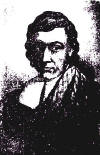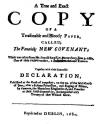|
Rev Donald
Cargill .

In every
group or society there is always someone that
everyone turns to for
advice or guidance on a topic, and so it was with the Rev. Donald
Cargill. By nature said to be timid and shrinking from
confrontation, yet this belies the steel in his backbone that
enabled him to be a constant source of guidance, direction and
authorship of Declarations by the strong principled Cameronians.
The son
of Laurence Cargill, a notary and gentleman of Rattray in
Perthshire he was born about 1619 but it was not until 1655 that
he was ordained for the ministry of the Barony Church in
Glasgow His father had some difficulty in getting the young
Donald to study divinity and at one point he was set upon
leaving Glasgow fearing that he was not up to the task. It is
said that he was in the act of mounting his horse when a
local woman berated him for leaving having “ appointed a meal
for poor hungry people , and will ye go away and not give it ?“
He stayed
but was among the 300 ministers who were ejected from their
church by the Earl of Middleton`s Act of Presentation and
Collation in 1662. He and his family were ordered not to live
anywhere on the south side of the River Tay and to take what
belonged to him out of Glasgow by the first of November 1662.
else he would be liable to imprisoned as “ a seditious person “.
It seems
that any early timidity and concern of being a minister had
left him by the time he was outed but was compounded by the
sad loss of his wife, Margaret Brown, after only one year of
marriage . Left with no real family ties, he became very active
in field preaching and private prayer meetings interspersed with
only a short break in Holland. In this time the field preaching
or ` conventicles ` became more and more frequent and of concern
to the government such that by 1670 they were being declared
illegal . In 1678 an Act was passed to enable military forces
to be raised for the suppression of conventicles. With this came
a hated tax, called the cess , to pay for the maintenance of the
troops. But undaunted the conventicles continued – in one area of
Lanark in February/April 1679 twenty Sabbath meetings were held in
a row.
A feature
of conventicles in the 1670s was the increasing number of armed
members of the congregation , and perhaps not surprisingly, the
soldiers tended to leave very large meetings alone. This however,
also gave rise to problems of conscience and some ministers
felt that there needed to be an explanation and justification
for this action. So it was, following a conventicle at Avondale,
May 25th 1679, that the leaders – Robert Hamilton, David Hackston,
John Balfour of Kinloch, consulted with Donald Cargill. The result
was the issue of another Declaration on Thursday 29 May, a day
set aside for the celebration of King Charles`s restoration. On
this occasion Robert Hamilton and some 80 horsemen set off to
issue it in Glasgow but found the way too strongly guarded.
They ended up at the market cross in the royal burgh of
Rutherglen where the document was read. The party then cast into
the celebratory bonfires ( for Kings Charles ) copies of the Act
Recissory ( that had annulled all the acts of parliament from
1640 to the Reformation in 1660); the Act of Supremacy which
asserted the King was superior in all things; the Declaration
which condemned the Covenants; the Act rejecting the Presbyterian
Church and establishing prelacy and the Act of Presentation and
Collation . When this was done a copy of the Declaration was
hung on the market cross, a prayer said and the party returned
to Avondale.
Although
in relatively mild language the Declaration at Rutherglen alarmed
the government and two days later John Graham of Claverhouse
was given full powers to look for its authors. Thus it was
that he arrived in Hamilton on the evening of Saturday 31st
May and unleashed his soldiers on the town. They found the Rev
John King in bed and he and 17 other people wre seized. From
this action it seems that Claverhouse learned of the conventicle
at Drumclog where he was to be put to flight by the
Covenanters the next day.
Donald
Cargill was again involved with trying to sort out policy as
the Covenanters argued and fell out with one another in the
period before the disaster at
Bothwell Bridge. Again the
Covenanters favourite device of another Declaration was involved, this
time debating whether the softer line of the Indulged ( those
ministers who accepted a compromise of some forms of prelacy and `
owned ` the king). Cargill was representative of the majority who
rejected the softer line of John Welch..
Despite having been out
voted, Welch nevertheless had his version of the Declaration
published at Hamilton, Glasgow, Lanark, Ayr and Irvine and became
known as the ` Hamilton Declaration `. The result was yet another
drafting task for Donald Cargill to reject the Hamilton
Declaration.
Between
the 19th and 21st June there was constant coming and going
between the two parties with Donald Cargill chief among the
negotiators There then followed a peculiar turn of events when
Welch and his group prepared a Supplication to present to the
Duke of Monmouth who had meanwhile arrived with 15,000 royalist
troops. In this the Rev John Blackadder was sent to Sir Robert
Hamilton to get his signature on the document and to say that
Donald Cargill begged him to subscribe to it. Hamilton signed
believing that Cargill had genuinely asked and was therefore
duped by Welch. However, the Supplication came to nothing with
Hamilton rejecting the terms of surrender sent by the Duke of
Monmouth and the Covenanters fell into defeat.
Another
phase began for Donald Cargill after the disaster of Bothwell
Bridge with his short relationship with the fearless
Richard
Cameron who had returned from Holland in the Spring of 1679.
In the heated persecution after Bothwell Cargill and Thomas
Douglas were two of the few who were brave enough to join Cameron
and the three united in services at Darmead in Cambusnethan and
at Auchengilloch a secluded glen south of Strathhaven. It was at
these meetings that discussion took place about a statement to
the world renouncing allegiance and disowning Charles II as a
tyrant and usurper.
The
Declaration of Sanquhar on 22nd June 1680 is major declaration
of faith, and indeed of war, which is often ascribed to Richard
Cameron but it is very likely that Donald Cargill was
responsible for its actual writing. But before this there was
another document of great moment that was not in fact published
by the Covenanters. This was
` The Queensferry Papers “. On 3 June
1680 Donald Cargill was in Queensferry along with Henry Hall, of
Haughhead a long time companion. He was a gentleman of some
property and lived in the parish of Eckford about six miles
south of Kelso. He was related to the Earl of Roxburgh .
Middleton, the Governor of the nearby Blackness Castle ( used as
a prison for Covenanters) was informed by the curates of
Borrowstounnes and Carriden of the presence of Cargill and Hall
and he immediately sought them out. By cunning and subterfuge
Middleton ingratiated himself with them and bought wine. After
taking a drink, Middleton demanded that they regard themselves as
his prisoners . Henry Hall restrained Middleton while Cargill
escaped but in the struggle Hall was wounded by Thomas George,
an excise man ( ` waiter `) who struck him on the head with a
carbine. Some women took him to a country house and doctors were
brought , but Dalziel of the Binns, of Rullion Green fame, lived
nearby and he came with guards and seized him. Although it was
plain to se that Hall was dying, Dalziel took him away to
Edinburgh, but his prisoner died on the way. It was in the
search of his clothing that the highly incriminating papers were
found. Thus its existence came to public notice from the
government and was not published by the Covenanters.
 The Queensferry Papers was a strongly worded and skilfully written The Queensferry Papers was a strongly worded and skilfully written
policy document or manifesto which attained its title from the
place in which it was discovered. It was a confession of faith
and also a rejection of sinful and wicked rulers and the
tyranny that came from government by a single person ie the
king. As such it was a bold and dangerous document which meant
certain death for the authors.
The
Sabbath after the Ayrsmoss battle of 22 July 1680 at which
Richard Cameron and his brother Michael had fallen, Donald Cargill
preached the sermon choosing as his text “ Know ye not that
there is a prince and a great man fallen this day in Israel “
But there was soon to follow a momentous meeting at
Torwood ,
between Larbert and Stirling, in October 1680. Here he preached
a sermon based on “ Thus saith the Lord God, Remove the diadem
and take off the Crown “. When he had done preaching he them
solemnly continued to excommunicate Charles Stuart, King of
England; James, Duke of York; James, Duke of Monmouth; John, Duke
of Lauderdale; John, Duke of Rothes; Sir George MacKenzie ( the
Kings Advocate also known as Bluidy MacKenzie ); and Thomas
Dalzell of the Binns.
Cargill
preached his last sermon at Dunsyre and it was the following
morning 12 July 1681 at Covington Mill, where he had been
resting, that James Irvine of Bonshaw captured him and his
companions, Walter Smith and James Boig. They were taken first
to Glasgow then to Edinburgh with their captor no doubt anxious
to collect the 5000 merks reward for
Cargill. They were soon sentenced to
be be executed and on 27 July 1681
Donald Cargill climbed the ladder saying
“
I go up this ladder with less
fear, confusion, or perturbation of mind, than
ever I entered a pulpit to preach. “.
After the
execution, as was the custom for traitors, his head was hacked
off and suspended above the Netherbow Gate alongside that of his
great friend Richard Cameron.
|